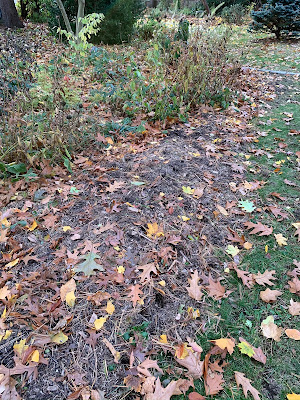 |
| Food compost from the closed bin will enrich the soil of the vegetable bed |
When I planted new areas, I spread compost on the soil surface before starting to dig. When I learned that harvesting (really mining) peat contributes to global warming by releasing carbon, I started mixing finished compost from the bins with coir (coconut fiber) to make homemade peat-free potting mix.
This year I haven't produced as much compost as I used to, and I'm going through it faster. Last year I gave away so many potting mix samples that I ran short of finished compost.
 |
| Cute, right? |
The reason for the samples was to interest garden club members I met in making their own peat-free mix. I thought if they tried mine, they'd see how easy it is to make a mix that looks, feels and functions a lot like commercial products based on peat.
Last year too I piled fewer fall leaves into the bins. I used to heap up leaves on the bins at the end of the gardening season, knowing the fluffy mounds would flatten during the winter, gradually decompose, and become part of the compost. But last year I went big on piling the whole leaves on beds to provide winter shelter for native insects.
 |
| Collecting leaves from the sidewalk to pile on garden beds |
Another call on my compost supply last year was the sheet composting project I started last March. The majority of the material for this composting-in-place soil improvement mound came from thick layers of wood chips and fall leaves. Thinner layers of compost were needed, though, to introduce soil organisms that would do the decomposing. I can see that they're doing their work. Already this fall the mound has sunk to about half its original height.
 |
| The sheet composting mound is sinking and starting to look like soil |
These extra demands on my compost economy have left the bins nearly exhausted this fall. Cutting down vegetable plants and emptying summer containers, I've started the process again in two of the four bins. According to the old system, though, the other two bins should be full of year-old developing compost. They're not.
 |
| The cupboard is bare |
In the past, I've just waited two years for the compost to be finished. Usually I make a point of adding garden waste to the compost as it comes, with no recipe. But I don't want to go through next summer with no finished compost. I may have to adjust my lazy-woman's composting method this year.
To get back on track, I can mix shredded leaves with the dead plants in the bins.
 |
| Shredded leaves will decompose faster |
Combining "brown" high carbon and "green" high nitrogen components will speed up the process. Desperate times call for desperate measures.
No comments:
Post a Comment